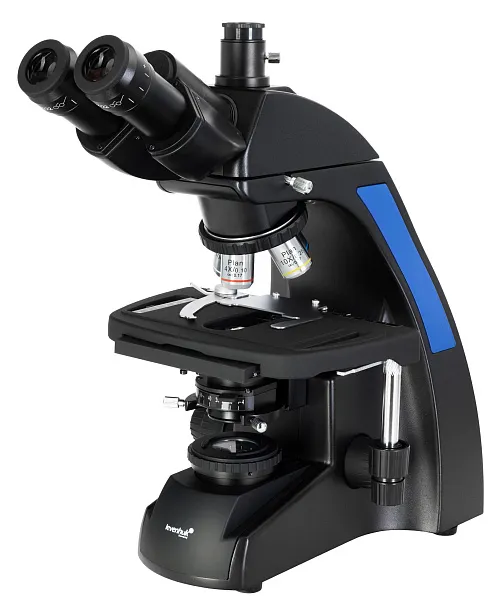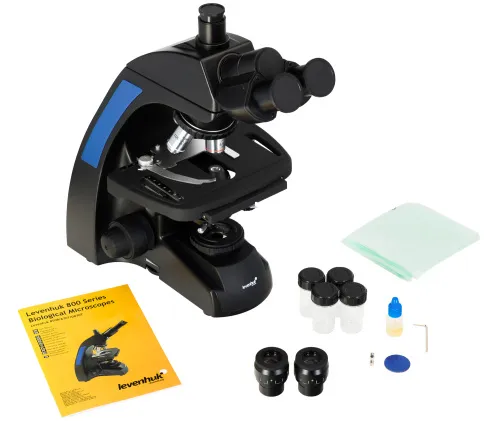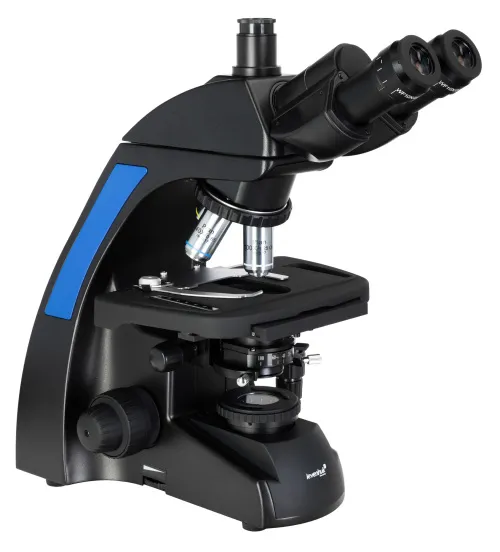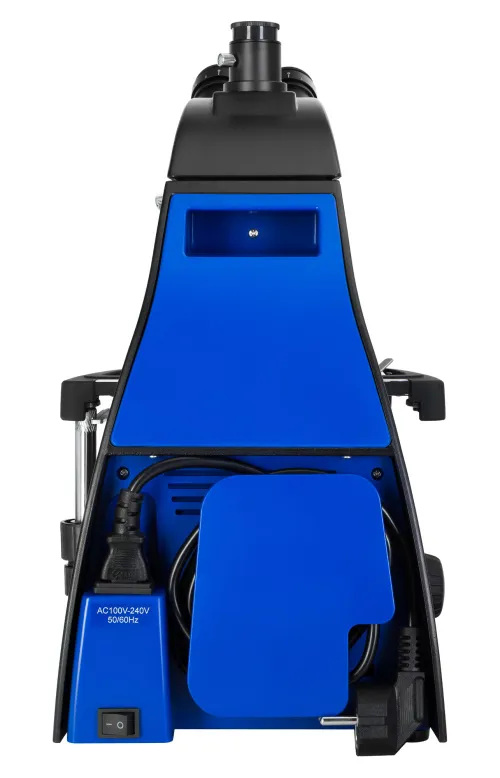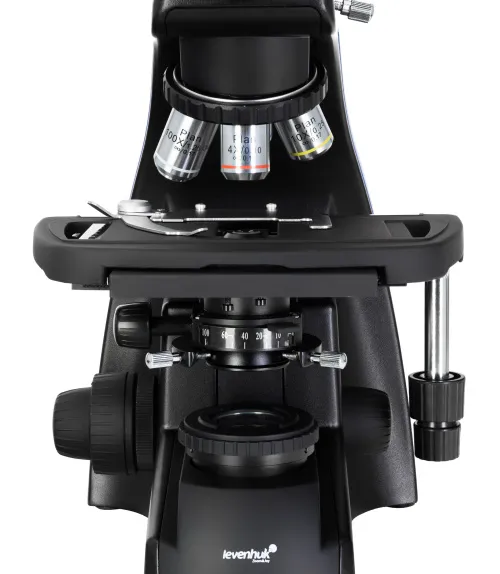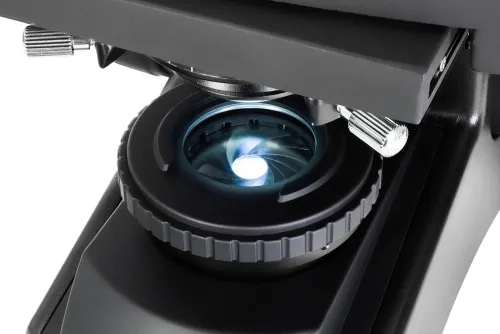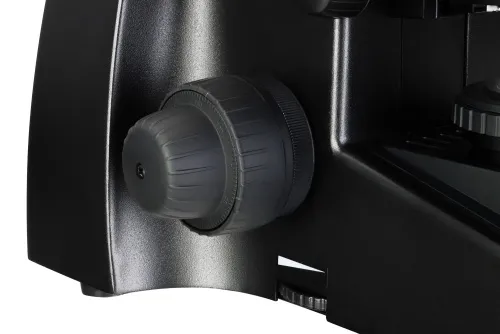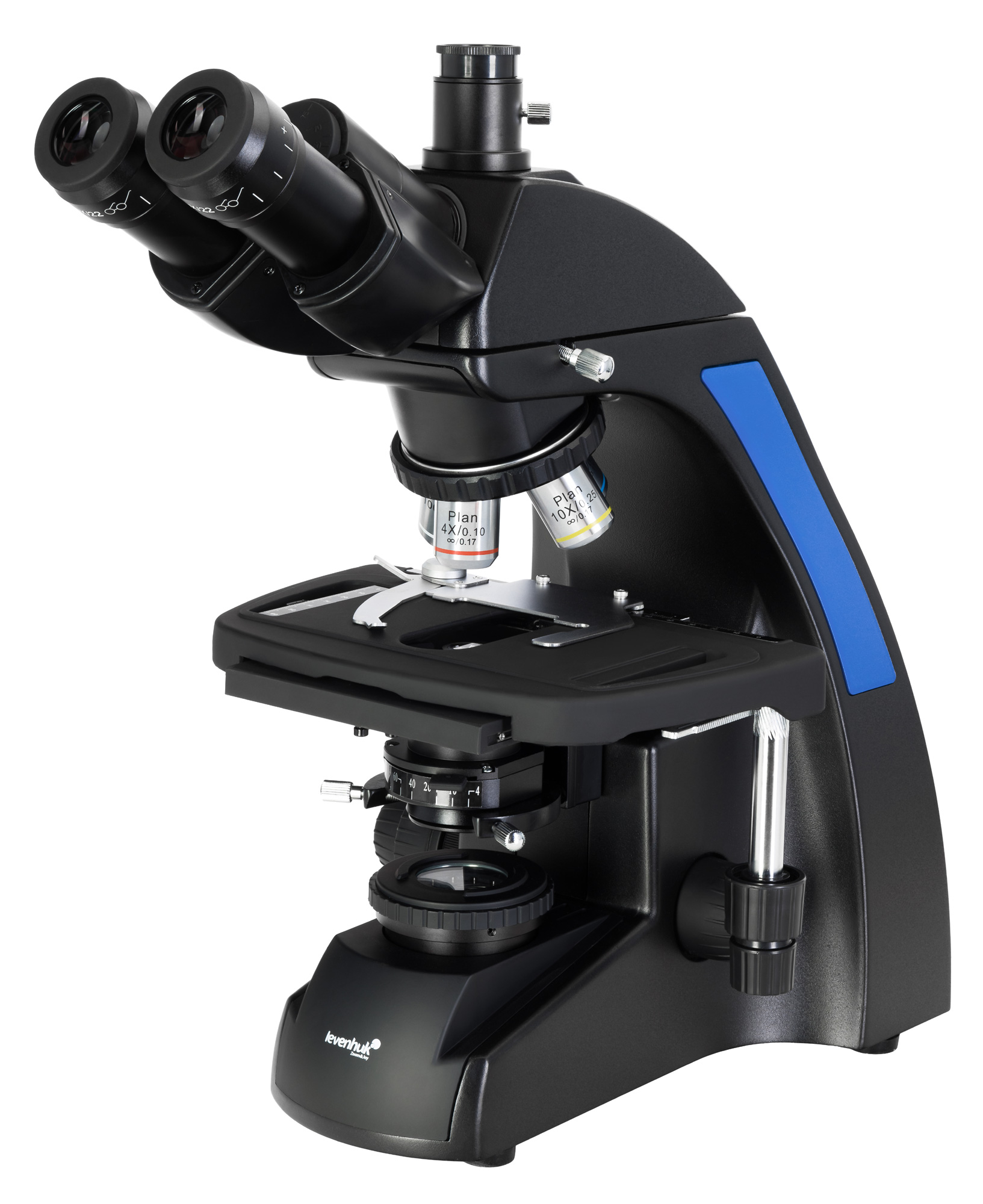Levenhuk 870T Biological Trinocular Microscope
Magnification: 40–1000x. Infinity plan achromatic objectives, light source – LED 3W, stage with two specimen holders, Köhler illumination
| Product ID | 24613 |
| Brand | Levenhuk, Inc., USA |
| Warranty | lifetime |
| EAN | 5905555004471 |
| Package size (LxWxH) | 52x39x32 cm |
| Shipping Weight | 9.12 kg |
The Levenhuk 870T is a trinocular biological microscope for brightfield observations in transmitted light. It is used in different types of medical centers for urological, dermatological, biological, biochemical, anatomopathological, cytological, and general clinical laboratory research. The microscope can be equipped with a digital camera to output images to an external screen, take photos, and record video. The camera must be purchased separately and is installed in the trinocular tube.
The head can also be tilted 30°. This tilt is comfortable for long-term work. The interpupillary distance is adjustable. The eyepieces have a wide field of view, and so it is convenient for the user to work with large samples. Four plan achromatic objectives are mounted in a revolving nosepiece that is oriented toward the interior. In this position, you can see the objective, and the space above the table is free.
There is no positioning rack on the stage and that improves the ergonomics of the device. The horizontal stage knob is located low for user comfort. The specimen holder is designed for two samples. The focusing knobs allow for coarse and fine focusing adjustment. All of the stage movements are smooth with no jerkiness.
The light source is located under the stage and the Abbe condenser. The LED is brightness-controlled and is powered by 220V. Thanks to LED illumination, the resolution of the microscope is higher than that of analogs with halogen bulbs. Both aperture and field diaphragms make it possible to set up the Köhler illumination.
Key features:
- For brightfield microscopy in transmitted light at magnifications from 40 to 1000x
- Trinocular head with a vertical tube for mounting a digital camera
- Plan achromatic objectives, wide-field eyepieces, revolving nosepiece oriented toward the interior
- Light source: LED, Köhler illumination, powered by AC power supply
- No positioning rack, two specimen holders, coarse and fine focusing
- Retractable collector for easy LED replacement
The kit includes:
- Microscope base, revolving nosepiece, condenser, stage, built-in transmitted light illuminator and power supply
- Trinocular head
- Plan achromatic objectives: 4x, 10x, 40xs, 100xs (oil)
- Eyepiece WF10x/22 mm (2 pcs.)
- Blue filter
- Bottle of the immersion oil
- AC adapter
- Dust cover
- User manual and warranty card
Caution: Please refer to the specifications table for the correct mains voltage and never attempt to plug a 110V device into 220V outlet and vice versa without using a converter. Remember that mains voltage in the U.S. and Canada is 110V and 220–240V in most European countries.
Some things you can see under a microscope:





The photo shows slides from Levenhuk ready-made specimen kits.
The Levenhuk 870T microscope is compatible with Levenhuk digital cameras (not included). Levenhuk cameras are installed in the eyepiece tube instead of an eyepiece.
| Product ID | 24613 |
| Brand | Levenhuk, Inc., USA |
| Warranty | lifetime |
| EAN | 5905555004471 |
| Package size (LxWxH) | 52x39x32 cm |
| Shipping Weight | 9.12 kg |
| Type | biological, light/optical |
| Microscope head type | trinocular |
| Optics material | optical glass |
| Head | 360 ° rotatable |
| Head inclination angle | 30 ° |
| Magnification, x | 40 — 1000 |
| Eyepiece tube diameter, mm | 23.2 mm (third vertical tube), 30mm (binocular head) |
| Eyepieces | WF10x/22mm (2 pcs.) |
| Objectives | planachromat: 4x, 10x, 40xs, 100xs (oil immersion) |
| Revolving nosepiece | for 4 objectives |
| Interpupillary distance, mm | 48 — 75 |
| Stage, mm | 210x150 |
| Stage moving range, mm | 75/55 |
| Stage features | two-axis mechanical stage, without a positioning rack, with specimen holders |
| Eyepiece diopter adjustment, diopters | ±5 |
| Condenser | Abbe N.A. 1.25 |
| Diaphragm | built-in aperture and field |
| Focus | coaxial, coarse (24mm) and fine (0.002mm) |
| Body | metal |
| Illumination | LED |
| Brightness adjustment | ✓ |
| Power supply | 110–220V |
| Light source type | 3W LED |
| Light filters | blue |
| User level | experienced users |
| Assembly and installation difficulty level | easy |
| Application | laboratory/medical |
| Illumination location | lower |
| Research method | bright field |
| Pouch/case/bag in set | dust cover |
Water that seems clear and uninhabited is actually teeming with a large variety of microorganisms that become available to our eyes through the lens of the Levenhuk 870T.
We have gathered answers to the most frequently asked questions to help you sort things out
Find out why studying eyes under a microscope is entertaining; how insects’ and arachnids’ eyes differ and what the best way is to observe such an interesting specimen
Read this review to learn how to observe human hair, what different hair looks like under a microscope and what magnification is required for observations
Learn what a numerical aperture is and how to choose a suitable objective lens for your microscope here
Learn what a spider looks like under microscope, when the best time is to take photos of it, how to study it properly at magnification and more interesting facts about observing insects and arachnids
This review for beginner explorers of the micro world introduces you to the optical, illuminating and mechanical parts of a microscope and their functions
All about Levenhuk microscopes
Authors of the MAD SCIENCE channel examine radioactive water from Pripyat river near Chernobyl
Watch the video "Nematodes, water bears, and forest flora under the Levenhuk 870T microscope" on the MAD SCIENCE YouTube channel to find out!
Short article about Paramecium caudatum - a microorganism that is interesting to observe through any microscope
Review of bestselling Levenhuk microscopes
Yes, the objectives designed as infinity focus lenses.
Please note, attaching SLR cameras is not supported by microscope construction. We suggest you use digital cameras designed specifically for this purpose: http://ca.levenhuk.com/catalogue/accessories/microscope-accessories/microscope-digital-cameras/ .
Yes, you can change the microscope lenses. The bore diameter of the eyepiece is 23.2 mm.
Is there any additional information you might need?
Looking forward to your reply.
100x OIL - immersion
A mirror can be used as a light source instead of the lamp.
2. Yes, a beam of light between binocular and the camera is controlled.
Type A is a classic immersion oil
Used as immersion liquid while working with apochromatic and achromatic objective lenses of microscopes of all types, except fluorescence microscopes, in visible spectrum.
Type B is a professional immersion oil
Used as immersion liquid while working with apochromatic and achromatic objective lenses of microscopes of all types, except fluorescence microscopes, in visible spectrum. Intended for microscopes with artificial illumination and image viewing system first of all. Compared to the classic immersion oil, immersion oil of B type has lower velocity and higher light transmittance.
No, vegetable oil cannot be used.
Do you want to process with the order?

